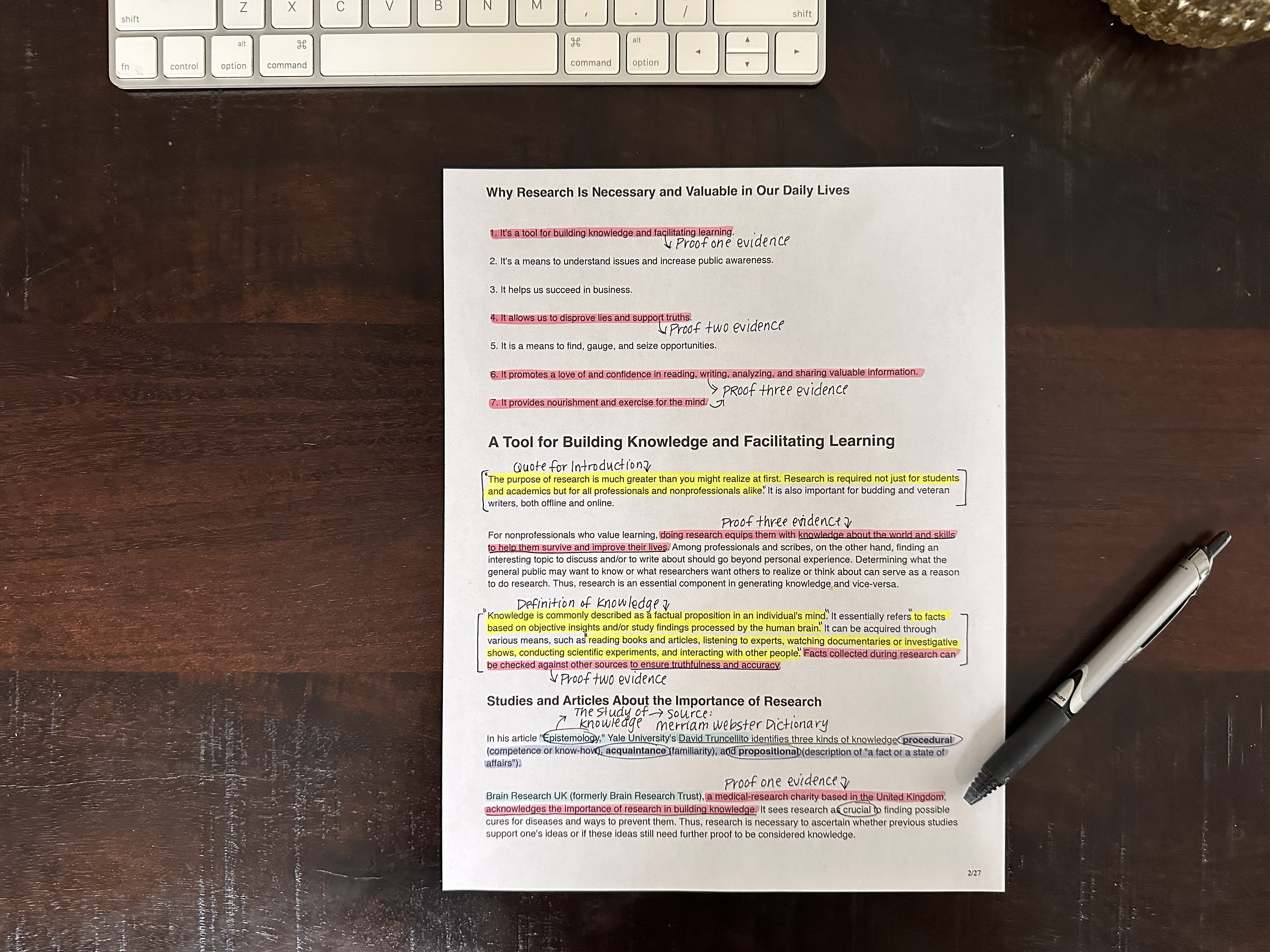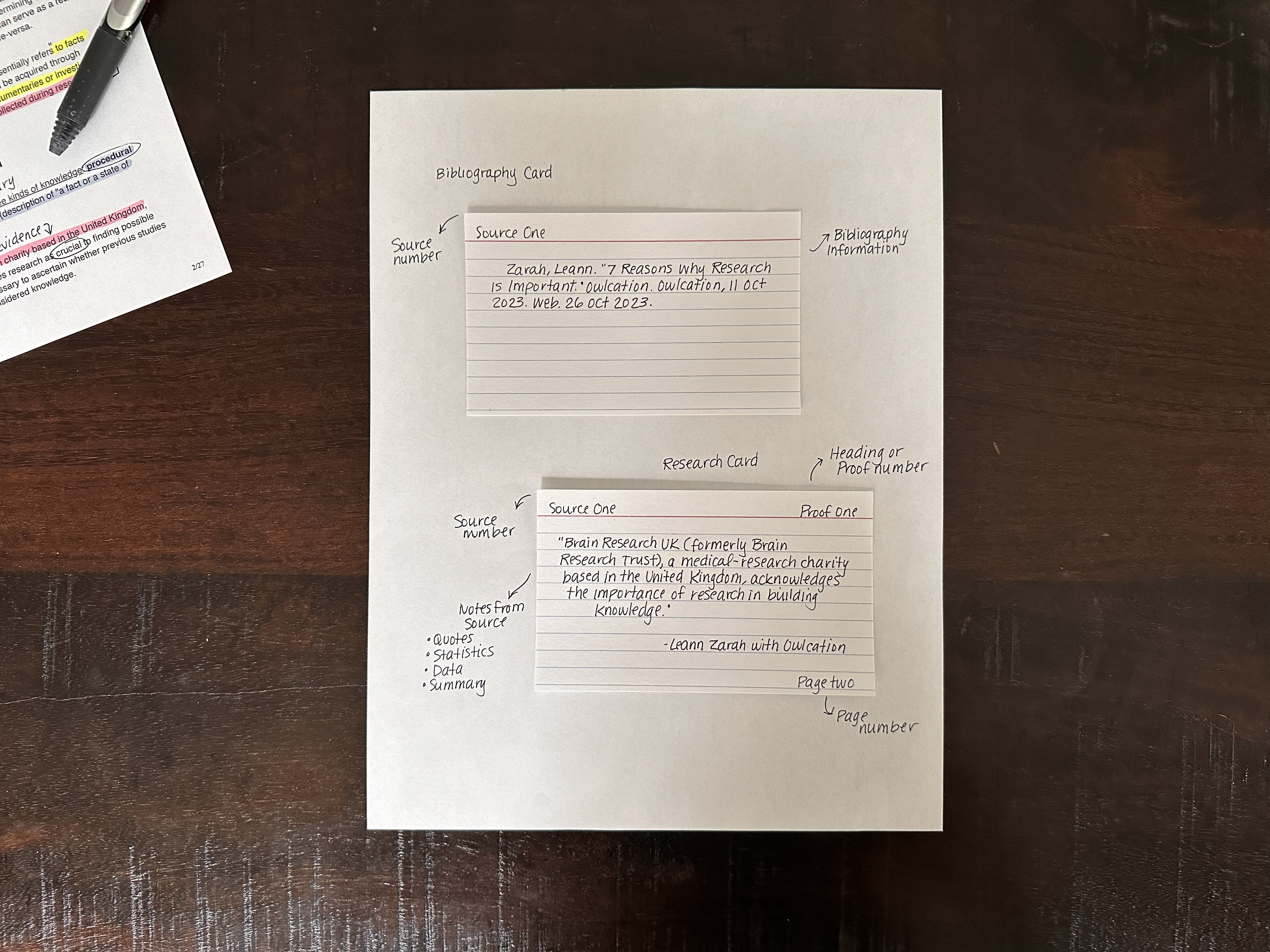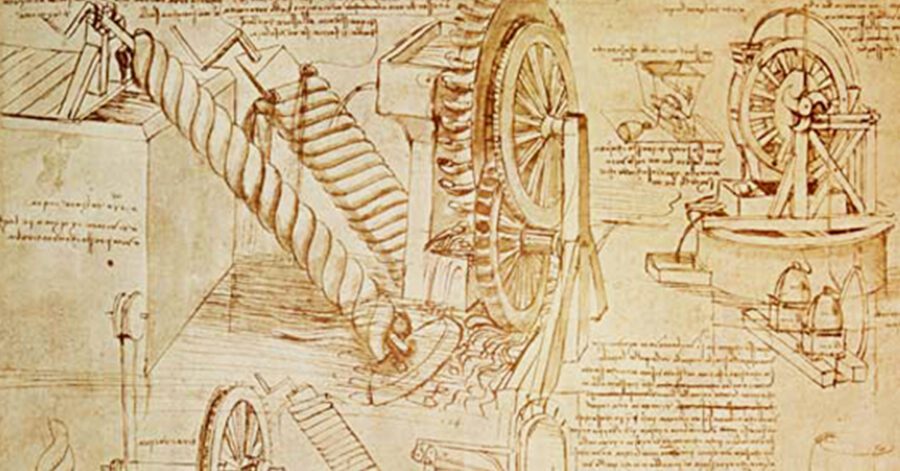Feeling overwhelmed by the prospect of a lengthy research paper looming on the horizon? You’re not alone! This guide is here to equip you with the tools and strategies to not just survive but thrive during this project. Whether you’re a Classical Conversations student, parent, or Director, or simply someone looking for a little help, we’ll break down the process into manageable steps, ensuring a successful and enriching research paper experience.
This guide goes beyond just “how-to.” We’ll expound upon the classical perspective, showing how this assignment fosters valuable skills like critical thinking, research, and communication. Plus, we’ll share tips for overcoming common challenges like finding reliable sources and avoiding plagiarism.
Ready to transform that research paper anxiety into research paper confidence? Let’s dive in!
(But first, a quick note on terminology: Classical Conversations is a classical, Christian homeschool program. The Challenge programs are equivalent to the high school years in traditional schools. This article was written by a Challenge graduate.)
Table of Contents
I. How to Write a Research Paper
II. The Fundamentals of Writing a Research Paper
III. The Steps to Writing a Research Paper
IV. The Value of Writing a Research Paper
I. How to Write a Research Paper
“Wait, what? I have to write a 10–15-page formal research paper?”
This was the question that went through my mind during Challenge I orientation. The assignment was both exciting and terrifying to me, but mostly, I just felt unprepared for it.
Something I wish I’d realized when I began my research paper was that no one expected me to already know how to accomplish this task. I was going to learn a lot about researching and writing through this project and Classical Conversations (CC) was not going to turn me loose to figure it out on my own. The same is true for you.
Whether you are a student, parent, or Director, there are many resources, tools, and tips that are available to help you through this assignment. However, sometimes it’s difficult to decipher which ones will help, and which ones are just unnecessary.
II. The Fundamentals of Writing a Research Paper
Why do CC students write research papers? What is classical about this assignment? How does this assignment benefit students? Questions like these—and many others—are likely going through your mind as you approach this monumental task. Because it is important to have clarity in every assignment, CC has provided answers to these questions.
1. Why write research papers?
“Students naturally have lots of questions. In the Research strand, we train students how to find the answers to their questions and to record their findings” (Classical Conversations Challenge I Guide, 18). By Challenge I, students are using the Dialectic art of the Trivium. This naturally results in the development of many questions about the world around them, and about the things they have learned. Whether a student has questions about the American Revolution or meteorology, a research paper will give them the opportunity to ask and explore their important questions and will teach them how to find true answers.
2. What is classical about this assignment?
Research papers are inherently classical because they require students to use the 15 Tools of Learning as they work through the three arts of the Trivium.
Students use the Five Core Habits of Grammar, which are naming, attending, memorizing, expressing, and storytelling, as they learn about the topic they choose to research and write about.
A knowledge of grammar will naturally lead students to apply the Five Common Topics of Dialectic as they ask questions about the grammar they have learned. The skill of inquiry is the bedrock of classical education. Made popular by the philosopher Socrates, questioning in order to challenge assumptions, test ideas, and arrive at truth is known today as Socratic questioning. This is the process that takes place during the invention stage of a research paper. Students will consider definitions, comparisons, circumstances, relationships, and testimonies concerning their topic of research to gain a deeper understanding and mastery of their subject.
Once students have found the answers to their research questions, they will use the Five Canons of Rhetoric to compose a paper that explains and analyzes their topic to an audience. The canons of invention, arrangement, elocution, memory, and delivery will equip them to communicate clearly and accurately.
3. How does this assignment benefit students?
The skills that students gain and practice throughout the process of researching and writing their paper are invaluable. This assignment “[Allows] students to present research in an orderly, logical manner that prepares them for writing in college” (Guide, 19). The intention of this assignment is not to finish with the perfect paper. It is to practice the classical skills of learning, to prepare for future education, and to develop the character of Challenge students.
III. The Steps to Writing a Research Paper
Let’s be honest. Writing a ten-to-fifteen-page paper is a daunting task. Because of this, it is essential that students have a good step-by-step process for researching and writing. CC believes that the 5 Canons of Rhetoric provides students with the best tools to use as they work to craft their lengthy paper. The canons give students direction as they invent their ideas; clarity as they arrange an outline; and style as they communicate to others through writing. Though there are five canons, for our purposes, we will make use of the first three. These are:
- Invention
- Arrangement
- Elocution
Invention
The invention stage begins with brainstorming a topic. From the Cold War to veganism, the possibilities for a topic are endless. Students should be encouraged to choose a topic that they are already interested in. They are going to spend a lot of time thinking, researching, and writing about their topic. So, to make that process enjoyable, it’s best to choose something that excites them. They should also select something that they have not previously researched. For example, if a student is interested in the history of automobile manufacturing, encourage them to research a car make that they have not previously studied.
It is during this stage of invention that the Five Common Topics are essential. By defining the terms involved; comparing their topic to similar concepts; researching the circumstances surrounding their subject; recognizing relationships in their research; and listening to testimonies about their topic, students will gain a deeper understanding of what they are interested in researching. This will ensure that students pick a reliable and exciting topic.
However, while the topic of their paper is important, students should not be anxious about which one they choose. It’s importance should be secondary to learning the skills of research and practicing the invention, arrangement, and elocution of their paper.
After a student has chosen a topic, they must write their topic in the form of a research question. A research question is a self-explanatory term, and can be defined as the question which you seek to answer through research. An example of this is “Is there value in assigning research papers to students in high school?” A research paper would then present evidence to prove a calculated answer to the question. Remember, the answer to the question in a research paper is completely dependent upon the evidence found and not on the writers opinion.
How to Find Research
CC requires students to have at least five sources for their research paper. At first, this may seem like a simple task–five google searches. But the amount of research required to write a reliable paper will likely lead to many more. Remember, five is the minimum, not the encouraged maximum. It is not uncommon to have ten to fifteen sources by the time students have completed compiling all their facts and information. And this is a good thing! More sources lead to more evidence which means more credibility for their work.
Nowadays, it is very easy to find an abundance of information on almost any topic through the internet. This poses both advantages and disadvantages to the researcher. An advantage is that research has been made accessible to the average individual. No longer do we have to comb through shelves and shelves of library books to hopefully find information on a topic. Now, research can be done by typing a few words into the google search bar–easy, efficient, effective.
However, we must also keep in mind the significant disadvantages that this results in. Quality in research is hard to maintain when many sources that can be found with the click of a button are entirely unreliable and sometimes, just downright false. I am sure we are all familiar with Wikipedia. But despite the abundance of unreliable research, it is still possible to find authoritative and accurate information, if we know where and how to look.
CC encourages students not to forsake the practice of turning to books and journals for their information. Though these books and journals can be intimidating at times, they often contain the best research because they go through a much more rigorous process of editing and fact checking than the average google search result. Despite this, it is not wrong for students to use the internet to their advantage. There are good digital articles that provide valuable information. Students just need to be taught the steps to evaluate the articles they read.
Learn more about Online Research Strategies with 7 Best Tips for Success
How to Evaluate Research
CC provides four questions in the Challenge I Guide (190) to use when vetting sources:
- What are the authors credentials? Does he or she have a doctorate or other advanced degree in the field?
- What are the organizations credentials? Is it a national organization? Is it accredited? What are its political affiliations? (Check the “About Us” page if there is one.)
- Do other sources confirm the information?
- How recently was the website updated?
Inexperienced authors, unreliable or politically charged websites, fringe evidence, or outdated posts are all indicators that an article contains unreliable research and should be discarded. By asking these questions, students will have the ability to recognize false information when they come across it. This is perhaps the most important step in the research phase, because without it you are likely to be relying on false facts which will discredit your work and render it worthless.
How to Organize Research
The question then becomes—what should they do with all this research once they find it? There have been many times during writing where I have frantically asked myself the question “Where did that source go?” Sources can easily get lost in pages and pages of notes or in a search history. That is why it is very important for students to have a system to organize their research.
There are many available methods to utilize when organizing research. Annotation can be used to highlight information in printed sources in order to keep track of key quotes and statistics.

Students can create digital lists with links and source summaries as an easy and efficient way to keep all of their digital research in one place, Or they can summarize and group research together on notecards to have quick access to source evidence and summaries. CC encourages students to use notecards because they are the simplest and most concise method out of the three. Notecards are also the preferred system because students can create both bibliography cards and research cards for their sources. Below is an example of a bibliography card and a research card.

The bibliography card contains all the information that will need to be cited in the students paper. This practice greatly benefits students later on when they go to complete their bibliography. Because they have already cited their sources on cards, they will not need to go back through to hunt down all necessary information. It will already be prepared for them to simply transfer into their paper. More instructions on how to rightly cite sources can be found in the following section of this article.
A research card contains all the information students have gleaned from their sources. This includes all quotes, statistics, polls, data charts, and facts. It is important that students limit each notecard to one piece of evidence. Every quote or fact should have its own notecard, this will make the process of topical organization even simpler later on in the arrangement stage.
How to Cite Research
Plagiarism is quite possibly the greatest offense in the research realm. CC defines plagiarism as “the failure to give proper credit [for information].” (192) Keep in mind that it is possible, and even likely, that those who commit this offense do it unintentionally and in complete ignorance. That is why it is important that students are taught to guard against plagiarism by citing their work well.
The first step to good citation is determining which citing style you must use. Citation style will fluctuate from assignment to assignment and from teacher to teacher. So, in order to know which to use, make sure to direct students to the proper authorities.
Citation Styles: MLA vs. APA
There are many citing methods they may come across, however, the two most prevalent are the Modern Language Association (MLA) and the American Psychological Association (APA).
While citing style is dependent upon the specific assignment or teacher, there are definitions of these styles that give us clues as to which may be used depending on the purpose or topic of a paper. MLA is broadly defined by Purdue University as the citation “used to cite sources within the language arts, cultural studies, and other humanities disciplines.” Purdue also defines APA as the style “most commonly used to cite sources within the social sciences.” So, for example, if students are researching the history of art during the Renaissance Period, they will most likely use MLA. If they are researching the functions of the brain, APA will commonly be the style used.
Both MLA and APA are extremely specific and require students to set up their paper with certain margin sizes, font choices, paragraph indentations, and so on. It is important that they understand the requirements pertaining to each style and become familiar with using them. More information on formatting requirements can be found here.
The Dreaded Bibliography
While citing is very important within a paper, the stakes are raised when students begin their bibliography.
Personally, the bibliography is the section of a paper that I dread working on. For years, I lacked a method for composing this seemingly dry and redundant piece of my work. I did not take the time to learn and master it and so, it mastered me. It wasn’t until I stepped back and began to learn the grammar of a bibliography that it became much simpler and less stressful. I encourage students, if they are like me, to review this article by Purdue University on the basics of bibliographies. Another resource that is helpful to use when writing a bibliography is a citation generator. This tool allows students to put in all relevant information from their sources, choose the citation style, and generate a bibliography with the click of a button.
Rather than waiting till the end of the assignment to create the entire bibliography, students may find it helpful to distribute the task as they find articles that they plan on incorporating in their paper. This will lighten the load and prevent it from becoming a last-minute burden.
Arrangement
Once they have compiled a minimum of five sources, it is time to begin arranging the information into an outline. CC instructs its students to have three to five main proofs (or main points) with at least three sub proofs under each main proof. Below is an example of an outline format commonly used in CC.
- Proof I
- Sub-Proof 1
- Sub-Proof 2
- Sub-Proof 3
- Proof II
- Sub-Proof 1
- Sub-Proof 2
- Sub-Proof 3
- Proof III
- Sub-Proof 1
- Sub-Proof 2
- Sub-Proof 3
Each main point is an answer to the research question and each sub proof is the support or evidence of the answer. For example, the research question is, “Is there value in assigning research papers to students in high school?” and the evidence points to the fact that there is value in high school research papers. So, Proof I could be “It develops research skills.” Each sub proof under that would then be either a quote or statistic supporting the fact that research papers develop students research skills.
It is very important that students arrange their outline so that the paper will make sense to someone who knows nothing about their topic. If there is information or background that needs to be explained before the research question can be understood, students should be sure to include it in their introduction. If there are terms not commonly used or understood, include the definitions when they are used. This allows the audience to read and enjoy the final paper with ease.
Arrangement is a tedious process of configuration, but it is vital if students want to end up with a paper that makes any sense to an outside reader.
If you or your student want more information on how to create an outline, I encourage you to review the Lost Tools of Learning curriculum. If you do not have this curriculum, you can purchase it at the Classical Conversations Bookstore here.
Elocution
The last canon to use when assembling a research paper is elocution. This canon focuses on the process of writing the paper. For some, this is the most difficult stage (I know it was for me). While writing my research paper, I was overwhelmed with reaching perfection on my first draft. I learned the hard way that writing is a process that is made up of many drafts, and that is okay. However, we do not want to end up with a poorly written paper. And so, CC has provided its students with five steps to go through as they edit and improve their work:
1. Check the content.
Does their paper answer it’s research question? It is clear, compelling, and constructive? At this point in the process, all the information should check out as accurate and true, but it is never too late to triple check. Students must ensure that they are providing good and credible research to the audience.
2. Check the organization.
Now that their paper is written, does the outline make sense? Could someone who had never heard of the topic before read through their paper and understand it? It is helpful to have a peer or parent, who has not previously been invested in their assignment, to read the paper. If they understand it, students have successfully done their job!
3. Check the transitions between proofs and paragraphs.
Are they abruptly jumping from one idea to the next or are there gentle transitions throughout? Smooth transitions will help the reader follow the writers train of thought as they read.
4. Check for clarity.
Does what the student is saying make sense? At this point in the process, they will be somewhat of an expert on their topic and paper. This is good because it shows that they have done their work well. However, it also means that they may overlook parts of their paper that do not make sense to an outside reader. Once more, this is when it is helpful to have someone unfamiliar with the topic read through the paper. Students should be encouraged to take head of any suggestions and critics their reader may have to offer because they are looking at the paper with fresh eyes and will probably notice errors that the student may have missed. This will help to ensure that the final paper provides clarity to the audience.
5. Check the grammar.
Spelling, word choices, and grammar must all be taken into account at this final stage of editing. Did students select the best words to explain their thoughts? Are they using the right “there” (or should it be “their” …)? This final process is the most tedious, but it is absolutely essential if students want to present a professional paper to their audience.
Through all of their writing and editing, remind students that they are writing a long paper. It is easy to get burnt out while writing, much more so when reading. Because of this, it is their job, as the writer, to engage their audience so that they are encouraged to continue reading. This means that it is important to take advantage of stylistic devices. When I first learned about grammar dress ups in CC’s Essentials program, I thought they were boring and unhelpful. But I have learned that that couldn’t be farther from the truth! The structure of a sentence has the ability to make it dull or delightful. Therefore, it is important that students use dress ups to make their paper an enjoyable read!
If they are unfamiliar with these tools of elocution, consider reviewing CC’s Essentials curriculum, which will give them step by step instructions on how to apply a wide variety of grammatical devices. If you are interested in purchasing the curriculum, you can visit the Classical Conversations Bookstore here.
After students have gone through this canon of Rhetoric, they will have completed their research paper!
IV. The Value of Writing a Research Paper
It is clear that the Challenge I research paper requires a lot of work from students. Once they are done, an honest question to ask is “What now?” They have done all this work for a paper that, years later, will probably not be read. This is when we remember that CC’s aim is not for student to check off assignments in their guide, it is for their character and capabilities to grow and develop through their education. Because education is the means to an end, not the end itself. So, the value of the research assignment far surpasses the assignment itself.
Believe me, the Challenge I research paper will be a milestone in your child’s education. It was in mine. It is a very valuable assignment that will foster in your student perseverance, responsibility, and discipline. Additionally, this task will equip your student with the skills they will need to accomplish future assignments as they continue their classical education.
What life skills did I cultivate through this assignment?
1. I learned how to research.
This has proved to be an essential skill through the rest of my CC education. It was especially relevant during the Challenge IV Senior Thesis project. Along with learning how to research, the methods or organization (specifically the note card method), taught me how to keep track of all my research. Once more, this was very helpful later on in my education, specifically during the Challenge I and Challenge II formal debates. If your student hoped they would never have to make another notecard after their research paper, I am sorry to disappoint them.
2. I grew significantly in my writing capabilities.
Writing did not come naturally to me in my early Challenge years. Every time I had to write an essay, speech, or 1AC, I struggled. But through the rigorous process of writing my research paper, I learned how to maintain my audiences focus through pages and pages of information.
4. Most importantly, I grew in discipline.
The theme of Challenge I is “Discipline is the cornerstone of freedom.”
There is no better assignment to build discipline than writing a research paper. The discipline to go through the right steps that result in a rewarding final paper is hard to maintain through the entire assignment but is worth it in the end. By practicing the virtue of discipline in researching, writing, and responsibility, I achieved the freedom that rests on the other side of the hard work.
Now, I am free to face a world where facts are often flawed because I know how to discover the truth of any topic. Additionally, I now have the freedom to communicate true facts to others through writing. And the need for these skills do not end after high school.
So, if you’re like me and you’ve exclaimed “Wait, what? I have to write a 10–15-page formal research paper?”—take heart. You can do it, because I did.





